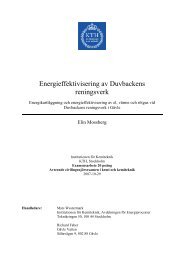Problematik vid höga flöden - Gästrike Vatten AB
Problematik vid höga flöden - Gästrike Vatten AB
Problematik vid höga flöden - Gästrike Vatten AB
Create successful ePaper yourself
Turn your PDF publications into a flip-book with our unique Google optimized e-Paper software.
clarifiers and were measured for VFA. The results showed that this sludge could be used as an<br />
extended resource for substrate for the primary sludge hydrolysis during high-flow conditions.<br />
The VFA content of the effluent water from the sedimentation tank was instantaneously<br />
increased by 46 % for the activated sludge, and by 81 % for the primary sludge. The mean<br />
value of VFA in the supernatant from the activated sludge was 559 mg/l and, from the<br />
primary sludge, 952 mg/l.<br />
A change in the programming of the surveillance system was implemented in order to pump<br />
less primary sludge to the clarifier during high-flow conditions. This was done to assure a<br />
certain amount of substrate during these conditions. Samples taken at the effluent showed a<br />
correlation between sludge volume in the tank hoppers and the production of VFA. This is<br />
shown in figure 6 and illustrates the importance of having enough substrate for sufficient<br />
VFA-production. A correlation was also found between the pH and the production of VFA.<br />
Measurements of pH could hence be used for an indication of sufficient VFA-production.<br />
VFA (kg/h)<br />
20<br />
16<br />
12<br />
8<br />
4<br />
0<br />
(a) VFA-feed in correlation to sludge<br />
volume<br />
R² = 0,6336<br />
0 50 100 150<br />
Sludge volume (m 3 )<br />
Figure 6. VFA-feed to the biological stage in correlation to (a) sludge volume in the hopper of the sedimentation<br />
tank and (b) pH in the effluent from the sedimentation tank.<br />
The inlet to the biological stage was rebuilt to prevent turbulent flow. Subsequently, DO<br />
concentrations were measured during high-flow conditions and showed that the anaerobic<br />
retention time had been secured.<br />
High DO-peaks in the aerobic reactors were prevented by implementing another change in the<br />
programming of the surveillance system. An automated change to a compressor with lower<br />
capacity during high hydraulic load was programmed. Another setup made it possible to<br />
choose different set points for the DO-level during normal and high-flow conditions, both in<br />
A1 and in A2. A further programming change was implemented to allow for different DOlevels<br />
in the beginning and the end of A2 by using two oxygen probes indi<strong>vid</strong>ually. The<br />
change to a high-flow set point was done depending on the airflow in the aerator-system in<br />
A1 which reflects the current load of oxygen demanding substances. The purpose of these<br />
changes was to reduce the concentration of DO during prolonged high-flow and endogen<br />
starvation conditions to possibly conserve PHA pools and thereby make process failures less<br />
likely. Proper control of aeration has also been shown to reduce the biomass decay (Siegrist et<br />
al., 1999).<br />
The point for bypass was moved from after the primary sedimentation tanks to before them, to<br />
be able to control the influx-flow and thereby avoiding the risk for sludge wash out from the<br />
60<br />
VFA (kg/h)<br />
25<br />
20<br />
15<br />
10<br />
5<br />
(b) VFA-feed in correlation to pH<br />
R² = 0.7099<br />
0<br />
6.8 7.2 7.6<br />
pH






